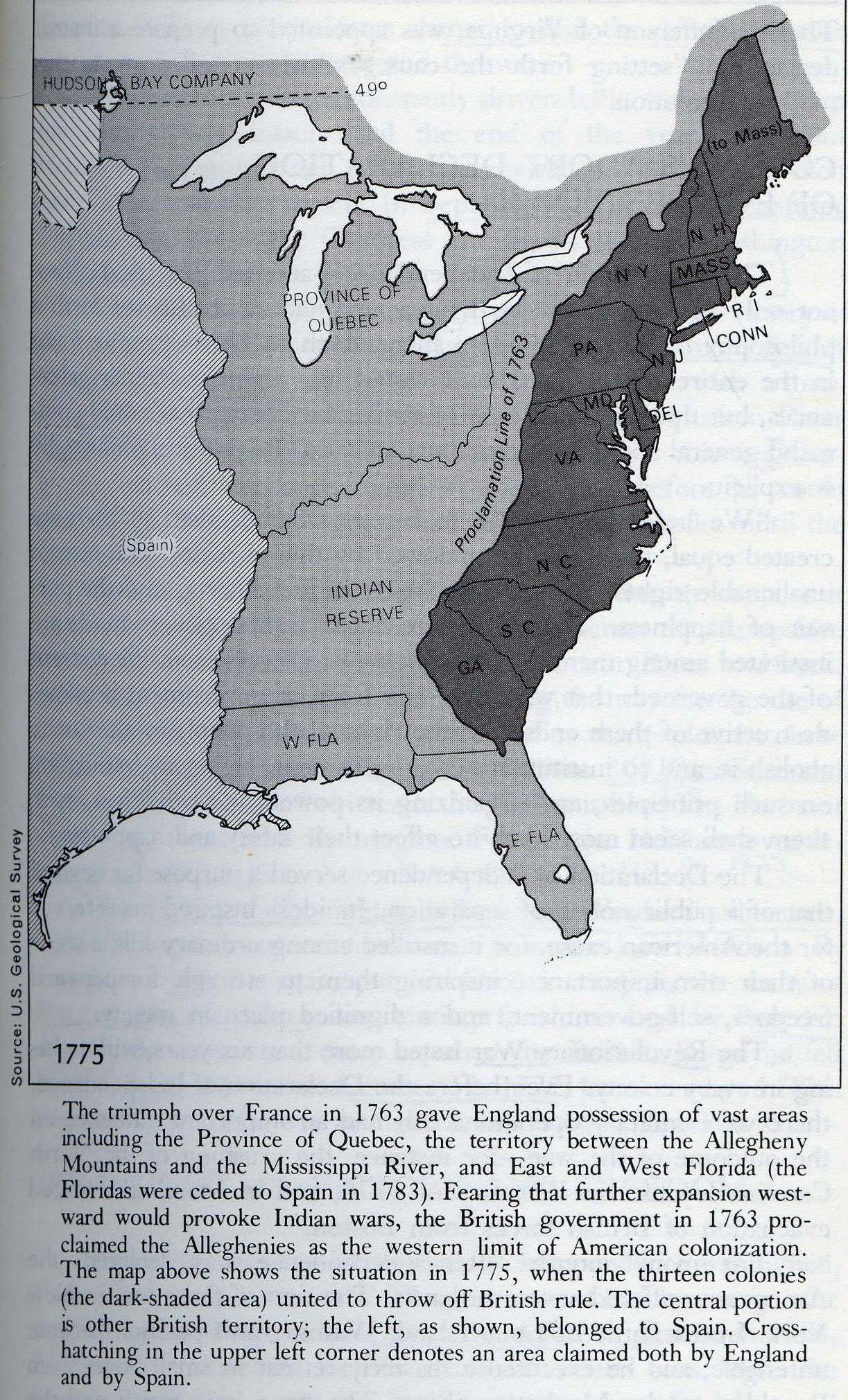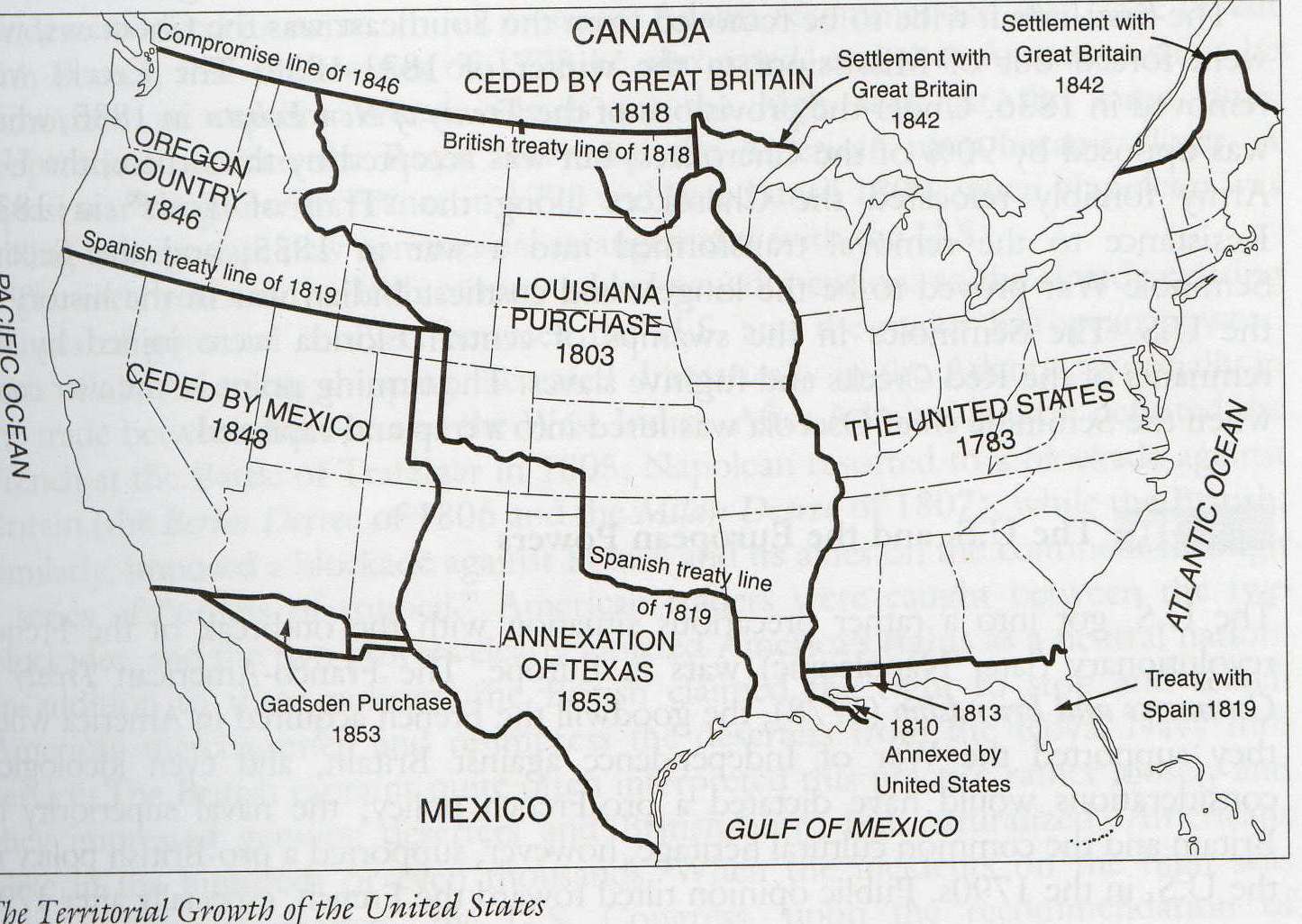
Territorial
Expansion
THE TERRITORIAL EXPANSION OF THE USA, 1783-1850
THE IDEA OF THE TERRITORIAL EXPANSION IMPLIES:
The westward movement
The earliest expeditions to the territories beyond the Rocky Mountains
The frontier life and its impact on American institutions and democracy
The growing influence of the west (Andrew Jackson and his presidency)
International treatises and territorial clashes with foreign powers (Spain-Mexico, Britain)
Indian wars and removal policy

Keith W. Olson et al., eds., An Outline of American History. United States Information Agency, n. d., p. 37.
DEFINING THE BORDERS OF THE NEW REPUBLIC
The Peace Treaty with Britain (1783): the Eastern border runs southwards from the Lake of the Woods along the Mississippi to the 31st degree of north latitude, then in the South, follows the border of Spanish Florida
Pinkney’s Treaty (Treaty of San Lorenzo, 1795): defined the 31st parallel as the border btw the USA and Spanish Florida; gave deposit rights to the Americans in New Orleans and shipping rights on the Mississippi
LAND ORDINANCES
From 1783 massive migration of Americans beyond the Appalachians
The original 13 colonies consider public lands as their own expansions
The necessity to clarify the status and the relationship of these lands to the original states (the states’ cession of western lands -> Public Domains)
The Ordinance of 1784: the Jeffersonian plan (to divide the western territories into 10 districts with self-government)
The Ordinance of 1785: surveying lands and dividing them up into townships (6 square miles, divided into sections of 640 acres)
The Ordinance of 1787 (Northwest Ordinance): created two territories of the western lands (the Northwest and the Southwest, divided by the Ohio); declared that 3-5 states can be formed in the Northwest; provided for the administration of the territory and formulated the conditions for self-government and later for statehood
THE LOUISIANA PURCHASE (1803)
Antecedents:
Tensions in the foreign policy with France
Undeclared naval war with France
1800 Sept: secret treaty btw France and Spain: France would take over Louisiana from Spain –> the Treaty leaks out -> American fears of the strengthening French positions in America -> Jefferson instructs his minister (James Madison) to start negotiations (with the Senate’s prior consent)
1802 Oct: the Spanish withdraw the American deposit rights in New Orleans
The Paris negotiations:
Livingston (American deputy in Paris) and James Madison (the minister of the American government authorized to offer $2-10 million for the purchase)
1803 April: beginning of the negotiations (Livingston’s information concerning Napoleon’s willingness to sell the territory)
Livingston and Madison sign the treaty, though the price of $15 million exceeds their responsibility
The Louisiana purchase doubled the territory of the US
The territory is not defined in the treaty (only referred to as the lands earlier belonging to Spain and France)
DEFINING THE BORDERS OF THE LOUISIANA PURCHASE
With Britain:
settling the relationships after the war of 1812-14 (status quo)
1817: Rush-Bagot Treaty: demilitarizing the Great Lakes
Convention of 1818: the boundary btw the USA and British North America is the 49th degree of north latitude from the Lake of the Woods to the Rocky Mountains; 10 years of joint possession of the Oregon Territory (prolonged for an unlimited period in 1827)
With Spain
1815: Jackson defeats the British troops in New Orleans
Jackson marches into Spanish East Florida (First Seminole War)
1819: Adams-Onís Treaty: the Spanish give over Florida to America, but they insist on their territories beyond the Rockies, whose border they consider the 42nd parallel (the Southern border of the Oregon Territory)
EXPANSION TO THE WEST AFTER THE 1820S
The Monroe Doctrine (later confirmed and elaborated by Polk in 1845 in connection with Texas and the Oregon Territory):
The American continent cannot further be the target of European colonization.
The American systems are essentially different from those in Europe.
Any attempt at expanding the European system in the Western hemisphere is dangerous for the peace and security of the USA.
The USA does not interfere either into the European colonies in the western hemisphere or into the internal affairs of European powers.
Indian removal policy (under the Jackson administration (1830s and 1840s)
1840s: tensions revived with Britain over Oregon as well as with the Mexican Confederacy (independent since 1821 from Spain)
THE LONELY STAR (TEXAS)
1821 and 1825: permission from the Spanish government and, subsequently, from Mexico for Americans to settle down (the first people to arrive: Austin and 200 families)
1830: the Mexican Congress prohibits further immigration of Americans -> petition movement of the settlers -> arrests -> settlers’ convention -> general Santa Ana annuls all ways of self-government
1836: declaration of Texas’s independence
1836: the Battle of Alamo: symbol of American resistance to the Mexicans (final defeat of the locals, all slaughtered by the Mexican troops)
1837 summer: Texas asks US Congress to formally annex its territory -> US public opinion split over the joining of such a large slave-holder territory
1836-45: independent existence of Texas (the British support it in order to prevent further American expansion towards the Pacific) -> American fears of a rival power on the mainland
1842: Mexico attacks Texas (cease-fire with British intervention, but no peace treaty)
1843: Mexican threat to the USA: the eventual annexation of Texas is casus belli
1845: Treaty with Texas -> Dec.: Texas joins the USA (the 28th state)
THE OREGON TERRITORY
Gradual definition of the borders of the territory:
1819 – the Adams-Onís Treaty establishes the 42nd parallel as the border btw Spanish California and the Oregon Territory
1824: negotiations with Russia -> the northern border of Oregon is set at 54° 40’ north latitude
1818: Convention with the British containing the joint possession of the Oregon Territory for then years
1827: prolongation of the joint possession of Oregon for an unlimited period
1844: beginning of the Oregon dispute (the fierce presidential campaign of 1844 focusing on Texas and Oregon: “Fifty four fifty or fight” – Polk’s campaign slogan, laying a claim on the whole Oregon Territory)
The Polk Corollary confirming and elaborating the Monroe Doctrine:
European powers cannot impede the union between a free state and the USA
European powers cannot establish colonies on the American continent
1845-: the American mission interpreted by the expression “Manifest destiny”
1846: The Oregon Settlement: compromise line drawn at the 49th parallel (the Northern border of the Oregon Territory defined, by cutting it into two halves); the British keep the territories to the north from the Columbia River
THE SOUTHWEST
Border disputes with Mexico: Rio Grande or the River Nueces in the South?
1846-48: The US Congress declares war on Mexico -> conquest of California
1848: Treaty of Guadalupe-Hidalgo: territorial gain in the South west
1853: the Gadsden Purchase (as a step in the rivalry btw the North and the South over the construction of the transcontinental railroad); a strip of land brought from Mexico to provide appropriate territories for a southern railway

Frank Tibor – Magyarics Tamás, eds., Handouts for US History: A Study Guide and Workbook. 2nd revised ed. Budapest: Panem, 1999, p. 147.